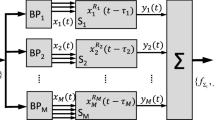Abstract
A method was demonstrated based on Infomax independent component analysis (Infomax ICA) for automatically extracting auditory P300 signals within several trials. A signaling equilibrium algorithm was proposed to enhance the effectiveness of the Infomax ICA decomposition. After the mixed signal was decomposed by Infomax ICA, the independent component (IC) used in auditory P300 reconstruction was automatically chosen by using the standard deviation of the fixed temporal pattern. And the result of auditory P300 was reconstructed using the selected ICs. The experimental results show that the auditory P300 can be detected automatically within five trials. The Pearson correlation coefficient between the standard signal and the signal detected using the proposed method is significantly greater than that between the standard signal and the signal detected using the average method within five trials. The wave pattern result obtained using the proposed algorithm is better and more similar to the standard signal than that obtained by the average method for the same number of trials. Therefore, the proposed method can automatically detect the effective auditory P300 within several trials.
Similar content being viewed by others
References
HILL N J, LAL T N, BIERIG K, BIRBAUMER N, SCHOLKOPF B. Attention modulation of auditory event-related potentials in a brain-computer interface [C]// IEEE International Workshop on Biomedical Circuit & System. Singapore: IEEE, 2004: 17–20.
SUWA S, YIN Y, CUI G, TANAKA T, CAO J T. A design method of an auditory P300 with P100 brain computer interface system [C]// 11th International Conference on Signal Processing (ICSP 2012). Beijing, China: IEEE, 2012: 152–156.
CAGLAYAN O, ARSLAN R B. P300 based auditory visual brain computer interface [C]// 20th Signal Processing and Communications Applications Conference. Mugla, Turkey: IEEE, 2012: 1–4.
SANEI S, AND SPYROU L. Separation and localization of P300 sources in schizophrenia patients via constrained BSS [C]// IEEE International Workshop on Biomedical Circuits and Systems. Granada, Spain: IEEE, 2004: 5–8.
CASTRO A E, DUQUE L, CASTELLANOS G. P300 analysis based on time frequency decomposition methods for ADHD discrimination in child population [C]// 17th Symposium of Image, Signal Processing, and Artificial Vision. Antioquia, Colombia: IEEE, 2012: 78–83.
LIU Z, CHEN K, LIU L, CHEN X R, RAO G X, LI H X. The feature of visual auditory P300 and correlations of intelligence quotient in severe traumatic brain injury [J]. Chinese Journal of Forensic Medicine, 2009, 24(5): 304–308. (in Chinese)
ZHOU J, LIU Q, XU W. Comparison of P300 in patients with senile depression and Alzheimer’s disease [J]. Journal of Neurology and Neurorehabilitation, 2012, 9(2): 77–79.
YANG J, LI Q, GAO Y. Task-irrelevant auditory stimuli affect audiovisual integration in a visual attention task: Evidence from event-related potentials [C]// IEEE/ICME International Conference on Complex Medical Engineering. Harbin, China: IEEE, 2011: 248–253.
AZAM S, BROWN T, JONKMAN M, DE B F. An acquisition method for the MLR of auditory evoked potentials [C]// 4th International Conference on Biomedical Engineering and Informatics. Shanghai, China: IEEE, 2011: 1036–1014.
JENNIFER L P, CARLOS A S. Method for automatic detection and classification of N1 and P2 auditory evoked potentials in EEG recordings [C]// 9th International Conference on Electrical Engineering, Computing Science and Automatic Control. Mexico City: IEEE, 2012: 1–6.
BEGUM T, REZA F, AHMED A L, ELAINA S, ABDULLAH J M. Analysis of event-related alpha oscillations in auditory P300 by wavelet transform (WT) method [C]// 11th International Conference on Hybrid Intelligent Systems (HIS). Melacca, Malaysia: IEEE, 2011: 162–166.
CABRERA A F, HOFFMANN P F. Single-trial classification of auditory event-related potentials elicited by stimuli from different spatial directions [C]// Annual International Conference of the IEEE Engineering in Medicine and Biology Society. Buenos Aires, Argentina: IEEE, 2010: 5807–5810.
NORMA C V, JAMES C J. Independent component analysis for auditory evoked potentials and cochlear implant artifact estimation [J]. IEEE Transactions on Biomedical Engineering, 2011, 58(2): 348–354.
ZHAO L Y, CAO J T, HOYA T, CICHOCKI A. Dynamic brain sources of single-trial auditory evoked potentials data using complex ICA approach [C]// 27th Annual International Conference of the Engineering in Medicine and Biology Society. Shanghai, China: IEEE, 2005: 4191–4194.
IYER D, BOUTROS N N, ZOURIDAKIS G. Aberrant auditory evoked responses in schizophrenia: Evidence from single-trial analysis [C]// 33rd Annual International Conference of the IEEE Engineering in Medicine and Biology Society. Boston, United States: IEEE, 2011: 4406–4409.
WANG J, CHANG C I. Independent component analysis-based dimensionality reduction with applications in hyperspectral image analysis [J]. IEEE Transactions on Geoscience and Remote Sensing, 2006, 44(6): 1586–1600.
LEE T W, GIROLAMI M, SEJNOWSKI T. Independent component analysis using an extended infomax algorithm for mixed Subgaussian and Supergaussian sources [J]. Neural Computation, 1999, 11(2): 409–433.
Author information
Authors and Affiliations
Corresponding author
Additional information
Foundation item: Projects(81460273, 61265006) supported by the National Natural Science Foundation of China; Project(2013GXNSFAA019325) supported by Guangxi Natural Science Foundation, China; Project(1348020-10) supported by Guangxi Science and Technology Program, China
Rights and permissions
About this article
Cite this article
Mo, Sf., Tang, Jt. & Chen, Hb. Automatically detecting auditory P300 in several trials. J. Cent. South Univ. 22, 2201–2206 (2015). https://doi.org/10.1007/s11771-015-2744-y
Received:
Accepted:
Published:
Issue Date:
DOI: https://doi.org/10.1007/s11771-015-2744-y




